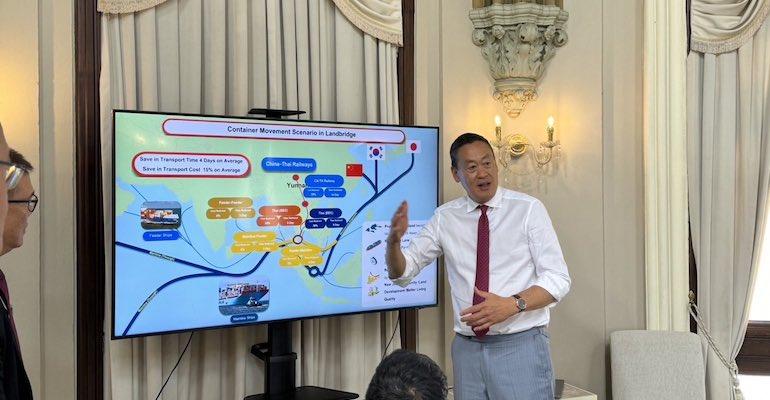Thai Prime Minister Srettha Thavisin is expected to pitch the 90 km landbridge at the Asia-Pacific Economic Cooperation (APEC) summit in San Francisco this week.
Two weeks ago the Thai Prime Minister posted on social media platform X (formerly Twitter) pictures a lunch meeting with country’s Transport Minister to prepare information on the landbridge for the APCE summit. PM Srettha said in the post he believed the project would be able to attract investors and elevate the economic development of Thailand to another level.
The 90 km landbridge would connect the ports of Ranong and Chumphon, with major deepsea terminals built in both locations.
The landbridge would have the capacity to transport 20 million teu of containers across the country bypassing the Malacca Strait and major ports in Singapore and Malaysia. Singapore is the world’s largest transhipment port connecting east and west, while Malaysia also has major transhipment terminals in the Port of Tanjung Pelepas and Port Klang.
Unlike previous iterations of the proposed link, it does not involve digging a canal but rather an overland connection, details of which remain sparse although would likely include motorways, railroad, and pipelines.
The Kra Canal was first envisaged nearly 400 years ago and its construction has been proposed on a number of occasions in recent decades, most recently in 2015 when agreement was reportedly signed between Thailand and China. Although both governments later denied this was the case.
According to Mahanakorn Partners Group (MPG) the landbridge received a significant milestone of Thai cabinet approval on 16 October this year.
The Thai PM has already sought interest in the project from China welcoming investors from the country.
“This will be a global mega-project, which will shorten the duration of goods transport via the channel of the Malacca Strait by six to nine days,” he said during the Thailand-China Investment Forum in Beijing on 19 October, Channel News Asia reported.
The largest portion of the investment, some $18 billion would be for the two deepsea ports in Ranong and Chumphon.
While the Thai PM estimated a six to nine days-time saving by vessels for bypassing the Malacca Strait it has been previously estimated as being just three - four days. While the inter-oceanic Panama and the Suez Canals - enable ships avoid having to sail round entire continents, South America and Africa respectively, by contrast the landbridge would save a transit approximately 1,200 km.
The Malacca Strait sees around 70,000 to 80,000 vessel transits annually and there have been warnings of it reaching capacity by the end of the decade. A hypothetical closure of the Singapore and Malacca Straits is estimated as costing shipping $65 million a week as result of diverting via the Sunda Strait.
Meanwhile the proposed landbridge in southern Thailand cuts across a politically unstable region of the Southeast Asian nation.
Copyright © 2024. All rights reserved. Seatrade, a trading name of Informa Markets (UK) Limited.
Add Seatrade Maritime News to your Google News feed.  |

